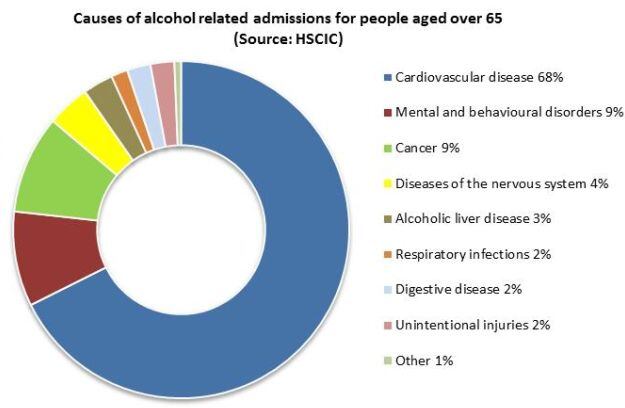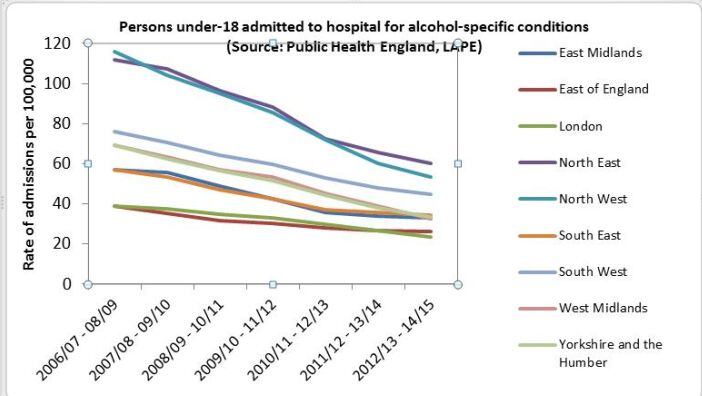Rather than noting that the vast majority of adults drink sensibly and safely, the headlines were more pessimistic; 'Alarm at over-65s boozing' (Daily Express), 'Growing toll of pensioners with drink problems' (Daily Mail) 'More pensioners suffering from alcohol problems' (The Times).
The picture is far more complex and more encouraging than the headlines suggest.
While alcohol-related hospital admissions among the over 65s have increased (up 3% since 2013/14) this age group also drink the least, consuming on average 10.2 units per week compared to 12.3 units among 16-44s and 14.3 units among 45-64s (HSCIC). Paradoxically, those over 65 still make up 48% of all alcohol-related admissions, and 68% of those are due to cardiovascular disease (HSCIC).
CVD is a complex condition and related to a variety of risk factors beyond lifestyle including hypertension, obesity, diabetes, ethnicity and family history. The PHE figures also tell us that those over 65 in the lowest socio-economic decile are 35% more likely to be admitted for an alcohol-related condition, than those in the highest.
These insights highlight the significant challenges in diagnosing ill health among an ageing population, and the complex interaction between lifestyle, inequality and getting older.

The way in which admissions are defined complicates the picture further. Describing the process of attributable fractions by which alcohol-related admissions are estimated, the Gov.uk website states: “There will be people who don’t drink alcohol whose admission will be included in the figures; injuries and illnesses that are entirely the result of alcohol use that are not given appropriate recognition; and circumstances where the contribution of alcohol is simply too complex to quantify...”
It is also important to distinguish between the number of admissions recorded in official statistics and the number of individuals admitted to hospital. No figures are available on how many times individuals are admitted for alcohol-related conditions, but official statistics cited by the Public Health Minister indicate that in 2012/13, 54% of admissions wholly attributable to alcohol were patients admitted twice or more (with 26% of those being admitted four times or more).
Given the frequency of hospital admissions among the elderly in general, it is likely that a similar pattern of repeat admissions is present among alcohol-related admissions in the over 65s.
Positive trends
However, the most striking aspect of PHE's new figures – and largely absent from the media's coverage – are the significant declines in alcohol-specific admissions for children and alcohol-related admissions for adults under 40.
The statistics show that, in just one year, there has been an 8% decline in under-18 alcohol-specific hospital admissions, and overall a 46% decline since 2008. In every region of England underage hospital admissions are falling, including in those areas that in the past have been disproportionately affected by alcohol-related harms, such as the North West (down 54%) and North East (down 46%).

These figures reflect the increasingly positive trends around young people and alcohol. Underage drinking (11-15) has fallen by 50% since 2003 and is currently at the lowest rate on record (HSCIC), and the number of children who think it is acceptable to drink has declined 22% since 2008 (HSCIC).
The new PHE statistics also indicate that alcohol-related admissions for those under 40 have also decreased, declining across nearly all regions in England and overall by 5% since 2013/14. The most significant fall over the last 7 years (20%) has come in the North East of England which suffers a disproportionately higher rate of admissions.
We have been making good progress in reducing alcohol-related harms, particularly in the last decade. Official statistics also show that, during this period, binge-drinking has fallen by 25% (ONS) and alcohol-related violent crime has declined by 40% (ONS).
While there are still local communities that need targeted support, the improving national picture is frequently overlooked by the media. Indeed research carried out by YouGov shows that the public, and specifically parents, are almost completely in the dark when it comes to the positive trends.
Highlighting positive social norms will increase momentum around the very culture change we all want to see, and will empower people with the knowledge that negative headlines can sometimes mask real achievements.
